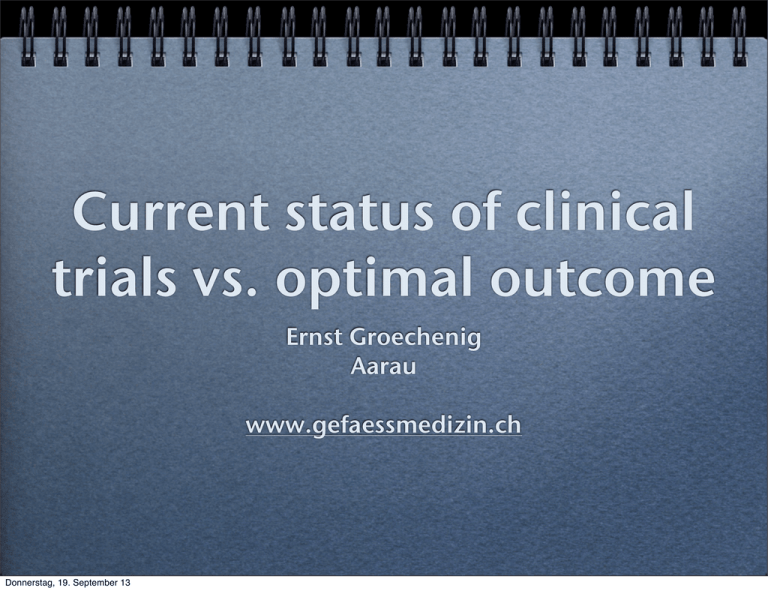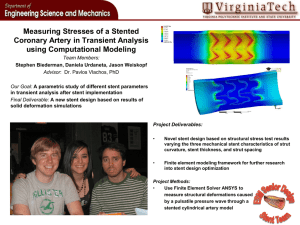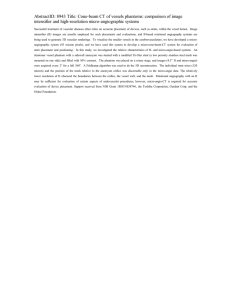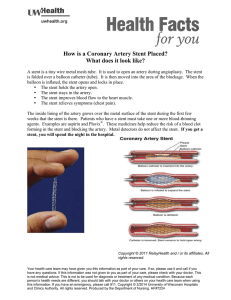Ernst Groechenig Aarau www.gefaessmedizin.ch
advertisement

Current status of clinical trials vs. optimal outcome Ernst Groechenig Aarau www.gefaessmedizin.ch Donnerstag, 19. September 13 Treatment of SFA occlusive diseases conservative treatment Angioplasty Pure Ballon Angioplasty Drug coated Ballons Atherectomy bare metal stents drug eluting stents Surgery Donnerstag, 19. September 13 DCB: Improving Outcomes & Options Improving Outcomes: notably good results Improving Options : nothing left behind Treatment DEB Anatomy Applicability No limitations Possible Outcomes Patent Vessel DEB Benefits No Metal Donnerstag, 19. September 13 Restenosis All options available DEB: Improving options pre- and post-treatment If stent, treating more focal lesions SFA - Stenting The bailout stenting concept • Significant residual stenosis • Flow limiting dissection Objective: improve technical success by a mechanical stabilization of the suboptimal segment Donnerstag, 19. September 13 SFA Stenting The extended concept of SFA-stenting • indication: all complex SFA lesion (>4 cm) Objective: - to improve technical success by a mechanical stabilization of the suboptimal segment - To reduce the restenosis rate at long-term Donnerstag, 19. September 13 FAST Trial Prospective, randomized, controlled – PTA vs. Luminexx nitinol stent (Bard) endpoints = duplex based patency + stentfracture PTA Intention to treat 121 123 On treatment 108 136 4.5cm 4.5cm Occlusions 25% 37% 1Y patency (duplex) 61% 68% Lesion length Schillinger et al, N Engl J Med 2006;354:1879-88, Circulation 2007. Donnerstag, 19. September 13 Stent NS RESILIENT Trial Prospective, randomized, controlled – PTA vs. triple helix nitinol Lifestent (Edwards - Bard) Endpoints = Duplex based patency + Stent fractures PTA alone Intention to treat 69 137 - - 6.4cm 7.1cm 38% 80% - 3% On treatment Lesion length 1Y patency (duplex) 1Y fracture rate Katzen et al, unpublished – presented at ISET 2008 Donnerstag, 19. September 13 Stent p<.0001 Astron Trial Prospective, randomized, controlled, PTA+optional stenting vs. primary stenting (Astron - Biotronik) Endpoints = Duplex based patency PTA + optional stenting Intention to treat On treatment 39 34 - - Lesion length 1Y patency (duplex) 8 8.4 cm 39% Schillinger et al, unpublished – presented at EURO-PCR 2008 Donnerstag, 19. September 13 Primary stenting 66% p<.05 ABSOLUTE Vienna Trial Prospective, randomized, controlled – PTA vs. Absolute nitinol stent (Abbott Vascular) Endpoints = Duplex based patency + Stent fractures PTA +/- stent Stent Intention to treat 53 51 On treatment 36 68 12.7cm 13.2cm 31% 54% - 2% Lesion length 2Y patency (duplex) 2Y fracture rate Schillinger et al, N Engl J Med 2006;354:1879-88, Circulation 2007. Donnerstag, 19. September 13 9 p<.05 Binary restenosis @ 12 months (%) restenosis vs. lesion length Data from randomised trials PTA Stent RESILIENT FAST ASTRON FAST ABSOLUTE RESILIENT Schillinger et al, unpublished – presented at EURO-PCR 2008 Donnerstag, 19. September 13 ABSOLUTE ASTRON Lesion length (cm) Stent Design First generation: Stent rings connected with longitudinally oriented bridges Donnerstag, 19. September 13 Stent Design First generation: Stent rings connected with longitudinally oriented bridges Donnerstag, 19. September 13 Stent Design First generation: Stent rings connected with longitudinally oriented bridges Donnerstag, 19. September 13 Stent Design First generation: Stent rings connected with longitudinally oriented bridges Second generation Stent rings connected with helically oriented bridges or peak-valley bridge Donnerstag, 19. September 13 SFA Stents peak-peak or peak-valley bridge Donnerstag, 19. September 13 SFA Stents peak-peak or peak-valley bridge Donnerstag, 19. September 13 Stentdesign spiral cell connection designed to disperse force uniformly peak to peak connection nodes Helical bridges: to combine flexibility, fracture resistance, radial force resists compression and provides excellent wall apposition three wave peak design Lifestent Donnerstag, 19. September 13 PROTÉGÉ® EverFlex Supera Stent Six pair of closed end interwoven nitinol wires with a closed cell geometry – flexibility – strength – fracture resistance Supera Donnerstag, 19. September 13 Supera Stent Six pair of closed end interwoven nitinol wires with a closed cell geometry – flexibility – strength – fracture resistance Supera Donnerstag, 19. September 13 Superficial Femoral Artery (SFA) • SFA steno-occlusive disease: – Short lesions (<5 cm) – Intermediate lesions (5-15 cm) – Long lesions (>15 cm) • Long-term patency of PTA in CLI is much lower than in claudicants: 20-37% 3-year PP • Different attempts to reduce low patency due to: – Recoil – Dissection – Intimal hyperplasia Donnerstag, 19. September 13 Choice of Treatment • Short lesions (>5cm): – PTA with provisional stenting • Intermediate lesions (5-15 cm): – PTA with self-expandable stent (Level 1a, Grade B) (Level 1b, Grade B) • Long lesions (>15 cm): – Venous bypass Especially beneficial in patients with life-expectancy >2 years (Level 1b, Grade B) – Synthetic bypass – thru pass for pts at high risk for open surgery (Level 3b, Grade C) Setacci C, de Donato G, Teraa M, Moll FL, Ricco JB, Becker F, Robert-Ebadi H, Cao P, Eckstein HH, De Rango P, Diehm N, Schmidli J, Dick F, Davies AH, Lepantalo M, Apelqvist J. Guidelines for critical limb ischaemia and diabetic foot. Chapter IV: Treatment of critical limb ischaemia. Eur J Vasc Endovasc Surg. 2011 Dec;42 Suppl 2:S43-59. Donnerstag, 19. September 13 how do you choose your stent? stent is stent, it does not matter price is value stentdesign chronic outword force (COF) diameter: oversize, undersize, medium size, exact size Donnerstag, 19. September 13 stenting: what can go wrong ? Oversizing: 1mm Excentric Lesions Ø6mm Stent Ø5mm Lumen COF Ø6mm Stent Ø6mm Lumen Donnerstag, 19. September 13 In SFA & Popliteal Stent/Vessel Diameter Changes with Leg Motion Bent Leg: 6 mm stent 4.38 mm Change in vessel diameter causes variable and increasing chronic outward force 3.31 mm 4.12 mm 2.98 mm 3.92 mm 3.12 mm 5.13 mm 5.02 mm Stent-vessel diameter range: 5.13 - 3.31 mm Nikanorov A et al. J Vasc Surg. 2009; 5 supplement: S24. Nikanorov A ., Schillinger M., ZHAO H., Minar E., Schwartz L. (2009). Assessment of Self-Expanding Nitinol Stent Deformation after Chronic Implantation into the Superficial Femoral Artery. Unpublished manuscript. Donnerstag, 19. September 13 Stent-vessel diameter range: 5.02 - 2.98 mm Self-Expanding Stents Are Not Designed the Same Increasing Outward Force Stent Designs with Different Behaviors Expansion force increases with decreasing diameter Flat expansion force Donnerstag, 19. September 13 Stents Must be Designed for a Broad Range of Vessel Diameters Bent Leg: 6 mm stent Stent-vessel diameter range, 5.02 - 2.98 mm Ideal Stent Design • Flat expansion force curve across a broad range of zero • Less concern for precise vessel sizing to minimize COF Increasing Outward Force Stent Designs with Different Behaviors in the Range COF, chronic outward force. Test(s) performed by and data on file at Abbott Vascular. Nikanorov A et al. J Vasc Surg. 2009; 5 supplement: S24. Nikanorov A ., Schillinger M., ZHAO H., Minar E., Schwartz L. (2009). Assessment of Self-Expanding Nitinol Stent Deformation after Chronic Implantation into the Superficial Femoral Artery. Unpublished manuscript. Donnerstag, 19. September 13 Expansion force increases with decreasing diameter Flat expansion force across broad range of diameters Less Optimal SFA Stent Design Increasing Outward Force SFA long-lesion (bent knee): 6-mm stent Vessel Diameter Range: 5.02 - 2.98 mm COF, chronic outward force; SFA, superficial femoral artery. Noted diameter range stated per instructions for use. Test(s) performed by and data on file at Abbott Vascular. Donnerstag, 19. September 13 Less Optimal SFA Stent Design Increasing Outward Force SFA long-lesion (bent knee): 6-mm stent Vessel Diameter Range: 5.02 - 2.98 mm Design limits usage range 45 N 16 N • Design limits use to a smaller diameter range • Design induces high COF and, therefore, more vessel irritation COF, chronic outward force; SFA, superficial femoral artery. Noted diameter range stated per instructions for use. Test(s) performed by and data on file at Abbott Vascular. Donnerstag, 19. September 13 Optimized SFA Stent Design SFA long-lesion (bent knee): 6 mm stent Vessel Diameter Range: 5.02 - 2.98 mm Increasing Outward Force Absolute Pro (6x100 mm Stent) COF, chronic outward force; SFA, superficial femoral artery. Noted diameter range stated per instructions for use. Test(s) performed by and data on file at Abbott Vascular. Donnerstag, 19. September 13 Optimized SFA Stent Design SFA long-lesion (bent knee): 6 mm stent Vessel Diameter Range: 5.02 - 2.98 mm Increasing Outward Force Absolute Pro (6x100 mm Stent) • Design allows use for a larger diameter range Design allows broader usage 13 N 11 N • Design induces low COF and therefore less vessel irritation COF, chronic outward force; SFA, superficial femoral artery. Noted diameter range stated per instructions for use. Test(s) performed by and data on file at Abbott Vascular. Donnerstag, 19. September 13 Goals to Optimized Stent Design and Clinical Performance ✓ Stent selection is critical ✓ Minimize restenosis risk with reduced COF Not all self-expanding stents are the same Maximize usage range for each size ✓ ✓ ✓ ✓ ✓ “Easy to Choose” “Easy to Use” Provide optimum scaffolding to promote healing and maintain patency without fracturing Donnerstag, 19. September 13 Goals to Optimized Stent Design and Clinical Performance ✓ ✓ Stent selection is critical Not all self-expanding stents are the same Thank you for your ✓attention Minimize restenosis risk with reduced COF ✓ Maximize usage range for each size ✓ ✓ ✓ “Easy to Choose” “Easy to Use” Provide optimum scaffolding to promote healing and maintain patency without fracturing Donnerstag, 19. September 13 www.gefaessmedizin.ch Donnerstag, 19. September 13




